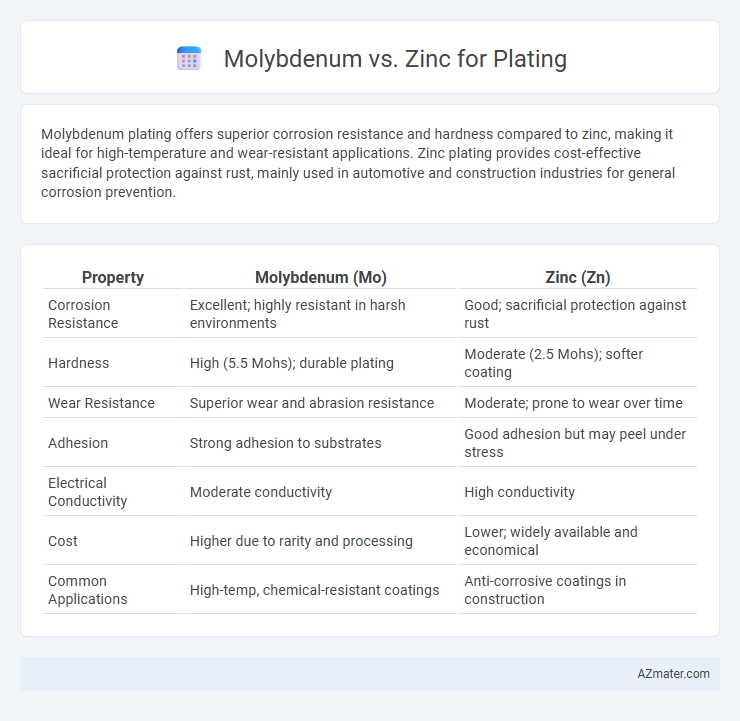Molybdenum plating offers superior corrosion resistance and hardness compared to zinc, making it ideal for high-temperature and wear-resistant applications. Zinc plating provides cost-effective sacrificial protection against rust, mainly used in automotive and construction industries for general corrosion prevention.
Table of Comparison
| Property | Molybdenum (Mo) | Zinc (Zn) |
|---|---|---|
| Corrosion Resistance | Excellent; highly resistant in harsh environments | Good; sacrificial protection against rust |
| Hardness | High (5.5 Mohs); durable plating | Moderate (2.5 Mohs); softer coating |
| Wear Resistance | Superior wear and abrasion resistance | Moderate; prone to wear over time |
| Adhesion | Strong adhesion to substrates | Good adhesion but may peel under stress |
| Electrical Conductivity | Moderate conductivity | High conductivity |
| Cost | Higher due to rarity and processing | Lower; widely available and economical |
| Common Applications | High-temp, chemical-resistant coatings | Anti-corrosive coatings in construction |
Introduction to Plating Metals: Molybdenum vs Zinc
Molybdenum and zinc are prominent metals used in industrial plating applications, each offering distinct corrosion resistance and mechanical properties. Molybdenum plating provides excellent hardness and high-temperature stability, making it suitable for aerospace and automotive components. Zinc plating is widely used for its cost-effective corrosion protection and sacrificial properties, especially in automotive and construction industries.
Chemical Properties and Composition
Molybdenum plating offers exceptional corrosion resistance and high-temperature stability due to its atomic structure and oxidation states, making it ideal for harsh environments, while zinc plating primarily provides sacrificial protection with its ability to form a stable oxide layer that prevents rust. Molybdenum's high melting point of 2,623degC and low electrical resistivity contrast with zinc's lower melting point of 419.5degC and greater chemical reactivity. The chemical composition of molybdenum, a transition metal with multiple valence states, allows for enhanced wear resistance and durability, whereas zinc's composition favors quick passivation and cost-effective rust prevention in industrial applications.
Corrosion Resistance Comparison
Molybdenum coatings provide superior corrosion resistance compared to zinc, especially in highly acidic and high-temperature environments, due to their dense and stable oxide layer. Zinc plating offers effective sacrificial protection against corrosion by forming a protective patina, primarily in moderate atmospheric conditions. For applications requiring enhanced durability in harsh chemical exposures, molybdenum plating outperforms zinc in preventing oxidation and extending component lifespan.
Mechanical Strength and Durability
Molybdenum plating offers superior mechanical strength and excellent wear resistance, making it ideal for high-stress applications requiring long-term durability. Zinc plating provides moderate corrosion protection and mechanical strength but is more prone to wear and can degrade faster under harsh conditions. Choosing molybdenum enhances load-bearing capacity and extends component lifespan compared to zinc coatings.
Surface Finish and Appearance
Molybdenum plating provides a smooth, matte surface finish with excellent corrosion resistance, making it ideal for applications requiring a subtle, uniform appearance. Zinc plating typically offers a bright, shiny finish with good protective qualities, often enhanced with chromate conversion coatings for improved luster and durability. Choosing between molybdenum and zinc plating depends on the desired aesthetic effect and environmental exposure, with zinc favored for a reflective, polished look and molybdenum for a more subdued, wear-resistant surface.
Cost Efficiency and Availability
Molybdenum plating offers superior corrosion resistance and hardness but comes with higher material and processing costs compared to zinc plating, which is widely known for its excellent cost efficiency and ease of application. Zinc plating remains highly available with well-established supply chains, making it the preferred choice for large-scale industrial use where budget constraints are critical. The availability of molybdenum is more limited and price volatility greater, impacting its cost-effectiveness for extensive or price-sensitive projects.
Plating Process and Techniques
Molybdenum plating utilizes chemical vapor deposition (CVD) or electroplating methods to form a hard, corrosion-resistant coating ideal for high-temperature and wear-resistant applications. Zinc plating primarily employs electroplating with an acid or alkaline bath, providing a sacrificial layer that protects steel from oxidation and enhances adhesion for subsequent coatings. The selection between molybdenum and zinc plating hinges on the specific requirements of mechanical strength, corrosion resistance, and operating environment, with molybdenum excelling in durability and zinc favored for cost-effective rust prevention.
Industrial Applications and Uses
Molybdenum plating is favored in industrial applications requiring high corrosion resistance, thermal stability, and wear resistance, particularly in aerospace, automotive, and electronics sectors. Zinc plating, commonly used for galvanizing steel, provides excellent sacrificial corrosion protection and cost-effectiveness in construction, automotive, and manufacturing industries. The choice between molybdenum and zinc plating hinges on specific performance needs, environmental conditions, and mechanical stress factors.
Environmental and Safety Considerations
Molybdenum plating offers superior corrosion resistance and lower toxicity compared to zinc plating, making it a more environmentally friendly option for industrial applications. Zinc plating, while cost-effective and widely used for rust prevention, can release hazardous substances such as zinc dust and cyanide-containing plating baths that pose health and environmental risks. Proper handling and waste treatment protocols are essential for both metals to minimize environmental impact and ensure workplace safety.
Choosing the Right Metal for Your Plating Needs
Molybdenum offers exceptional hardness and corrosion resistance, making it ideal for high-wear applications requiring durability and thermal stability. Zinc provides excellent sacrificial protection against rust and is more cost-effective for general-purpose plating on steel and iron components. Selecting the right metal depends on specific requirements such as environmental exposure, mechanical stress, and budget constraints.

Infographic: Molybdenum vs Zinc for Plating
 azmater.com
azmater.com